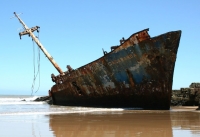
The scientist working with the marine environment understands electrochemistry. The high conductivity of the electrolyte and the rapid rates of marine corrosion makes electrochemical testing the ideal tool for evaluating metals, inhibitors, coatings, aeration and water chemistry. The scientists working at ACM understand electrochemistry and we have successfully made quality instruments for the marine scientist since 1986.
The first instrument of choice in the marine research laboratory is the Gill 8. With this the marine scientist may perform a full range of Electrochemical Impedance Spectroscopy (AC Impedance) tests including Harmonic Analysis and a full range of DC tests such as Current and Voltage Noise to look for localised corrosion, LPR to determine general corrosion, Cyclic Sweeps to study the electrodics of the cell, and Polarisation to simulate Cathodic Protection systems. The Gill AC is a smaller, lower power (only 1 Amp output current), single channel instrument that does, however, perform all the tests of its larger brother.
This is often chosen by universities as a very cost effective one student / one instrument solution. In the marine environment mixed metal systems can cause spectacular rates of metal dissolution, ideal for researching with the ACM Instruments Weld Tester. The forerunner of this instrument was originally named this and its successors have inherited the same name, they don't just test welds but any mixed metal system. An example could be a cooling water intake for an engine with a mix of brass, stainless and mild steel, copper and aluminium. A single channel of the Weld Tester will couple each of these metals with its own 8 range ZRA and perform AC and DC tests simultaneously. A test in the Sequencer might be to monitor the galvanic currents flowing between each of the couple elements, perhaps to find the effect of flow rate. The instrument may be ordered with a single channel, or four, eight or twelve channels. For offshore use, the Field Machine has been designed around an 'Underwater Kinetics' divers case. Housing the instrument and portable PC this is the preferred equipment for marine scientists away from the lab. All the laboratory tests supplied with the indoor models are available with the Field Machine, just plug into a probe, start the test and close the lid, the Sequencer will take care of the tests.
For Sacrificial Anode manufacturers we have developed the Anode 16. The instrument is used to determine the potential and current carrying capacity of alloys used for Cathodic Protection. It provides an easily used and reliable method of screening batches of sacrificial anodes to ensure performance consistency for batch to batch. Built to standards you require e.g DNV-RP-B401, NACE TM0190, NORSOK M-503, AS2239 plus many more and can also be used for long term testing.
For scientists checking the effect of CP systems we make the Pot 16 and Gal 16. These two instruments are used to check the susceptibility of coatings to cathodic disbondment and blistering using potentiostatic and galvanostatic techniques respectively. The Parallel 30 LPR is used to test multiple electrodes in sea water and the GalvoGill 12 used to monitor galvanic currents. The last four instruments are examples of ACM's speciality range. Also available for the marine scientist are our one-off models designed and built to your specification. For a rapid quote for a unique solution please contact us, we will usually quote within 24 hours.
See Application Notes for more information on AC Impedance (EIS), inhibitors, welds, seawater, Cyclic Voltammetry, Current and Voltage Noise and LPR techniques plus many more.
